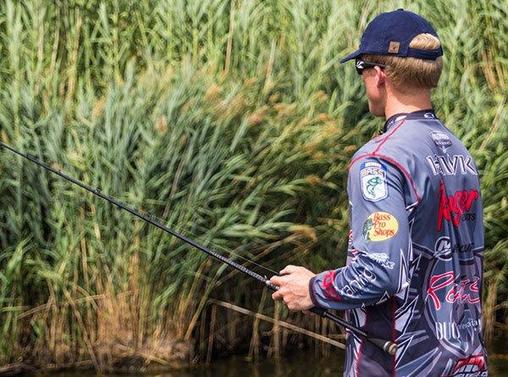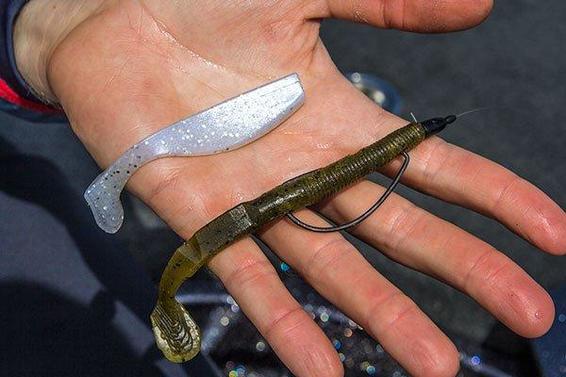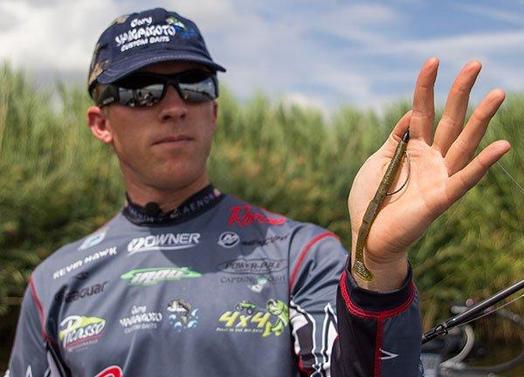It’s no big secret—cooler, fall weather offers anglers some outstanding shallow water bass fishing opportunities. While it’s tempting to join the masses and chunk noisy, hard reaction baits, small swimbaits for bass are a great alternative when fishing shallow cover.
Elite Series pro and 2010 Forrest Wood Cup Champion Kevin Hawk does a lot of damage when fishing small swimbaits in shallow water throughout the fall. Whether he’s targeting pressured bass or battling high barometric pressure, it has has quickly become one of his most productive techniques.
The driving factor
We’ve all heard it until we’re blue in the face—it’s important to match the hatch. Although it sounds cliché, this theory holds very true in the fall months. As the shad make their migrations to the shallows, bass are usually right behind them. Emulating a bass’ natural food source can produce great results this time of year.
“Small swimbaits are an outstanding imitation of shad because of their tight shimmy and subtle profile,” Hawk said. “The bass will still eat crawfish and other types of forage, but most of them are totally consumed with shad once fall begins.”
Big swimbaits are known for catching big fish, but be careful not to rule out smaller, more subtle swimbaits for quality bites as well. Small swimbaits have the potential to produce both quality and quantity throughout the fall, which is especially helpful for the tournament angler.

“If I go out and heave a big swimbait for an entire tournament, there’s a good chance I might get just a few bites,” Hawk said. “They’ll likely be big bites, but it can be hard to fill a limit with such a large bait. Small swimbaits give you the best of both worlds—not only can you catch big ones with it, but you can also fill out your limit.”
Blow their cover with a small swimbait
Many of us have experienced the frustration of a big bass following our swimbait to the boat without eating it. Not only is it the epitome of heartbreak, but it can really mess with an angler’s confidence. Hawk actually considers this a good thing during the fall months.
“When a bass noses your swimbait back to the boat, it gives away their location,” Hawk said. “Finding bass is the hardest part of our sport, so anytime you know where one lives, it makes your job a lot easier.”
Hawk makes careful mental notes any time he notices a wary bass following his swimbait. After letting the area rest for roughly 30 minutes, he’ll come back locked and loaded with a totally different presentation.
“When I revisit an area, I love to cast a jig or wacky rigged Yamamoto Senko at them—more times than not, they’ll eat it,” Hawk said. “It’s important, however, to approach the area from a totally different angle than you did with the swimbait in order to fool the bass. It’s already suspicious, so you’ve got to be deliberate in your approach.”
Too much bait?
The millions of shad that flood shallow water areas in the fall can be both a blessing and a curse. Bass will be in the immediate vicinity, but having too much bait can make it difficult to differentiate your offering from the real thing. To overcome this common problem, Hawk makes a few simple changes.

“Simply changing your swimbait size can make a really big difference when you’re surrounded by shad,” Hawk said. “I’ll choose a swimbait that’s a different size from all of the shad in order to make my bait stand out a little more. If I want my swimbait a little smaller, I’ll use a 3 1/2-inch Yamamoto Swimbait and when I decide to upsize, I’ll usually go with a 5-inch Yamamoto Swim Senko. Both are excellent swimbaits that catch a lot of bass.”
Get better quality out of schooling bass
Catching numbers of schooling bass is generally not a problem for anglers in the fall. Finding those quality fish is a different story, however. If you find birds circling a big school of active bait and bass, consider small swimbaits instead of traditional topwater lures.
“If you’re targeting schooling fish with topwaters and having a hard time eluding the smaller bass, you can use smaller swimbaits to catch the bigger ones,” Hawk said. “The fish you see busting on the surface are usually pretty small, but if you cast a Swim Senko or Yamamoto Swimbait into the school, you’ll be surprised by how much bigger your catch will become.”
Hawk likes to make a long cast past the active fish and let his swimbait sink on a slack line for roughly two seconds before beginning his retrieve. Big bass aren’t entirely fond of feeding competition, so they’ll tend to suspend below the smaller fish. While most anglers target the fish they see on the surface, a small swimbait helps Hawk specifically target these larger, less active bass.
Slow and steady wins the race
We always see pro anglers tinkering with their retrieves while fishing hard reaction baits, so you’d think it’d be important with swimbaits, too, right? Hawk is a big believer in a slow and steady retrieve, even when experiencing short strikes.
“If I’m fishing a small swimbait in the fall, I’m rarely doing anything special with my retrieve,” Hawk said. “I just wind it along slowly and work it almost like a spinnerbait. When a bass short strikes it, your reaction may be to change your retrieve speed, but you’ll get more follow-up bites if you keep it the same.”
Although a steady retrieve speed is recommended in most situations, Hawk will change things up when he’s fishing around specific pieces of cover. As the swimbait nears the cover—whether it’s a laydown, stump or a grass line—he’ll pause it for two seconds to keep it in the strike zone longer.

Hawk uses a Swim Senko rigged on a 3/0 Owner Wide Gap Hook with a pegged 3/8-ounce bullet weight when fishing around heavy cover.
“Stopping your swimbait near cover makes a big difference, especially in post-frontal weather conditions,” Hawk said. “They’ll be holding tight to the cover and you need to give them a little extra time to react to your presentation.”
Land more bass at 45 degrees
For some of us, it would make plenty of sense to set the hook on a small swimbait as you would a crankbait, with more of a ‘sweeping’ action. While it may not seem as natural at first, Hawk suggests setting the hook at a 45-degree angle to increase your hookup ratio.
“It’s really important to watch your line, because they’ll knock slack in it a lot of time,” Hawk said. “When you feel pressure, pause for a second to make sure they have it, then set the hook at a 45-degree angle to stick them in the hard part of their mouths.”
Gear recommendations
- Hook: 4/0 Owner Weighted Twistlock (Swim Senko) and 3/8-ounce Owner Ultrahead Inshore Head(Yamamoto Swimbait)
- Rod: 7-foot, medium-heavyiRod Air 703 Casting Rod
- Reel: 6.4:1 Abu Garcia Revo SX
- Line: 15 to 20-pound Seaguar InvizX Fluorocarbon
All credit for these awesome tips goes to Wired 2 Fish. https://www.wired2fish.com/fall-fishing/why-you-should-try-small-swimbaits-for-fall-bass/





